I’m New Here: Weeks Fourteen & Fifteen…
May 24, 2019 by Stephanie Williams · Leave a Comment
Last week I didn’t post because I was involved in a local amateur production of Disney’s Beauty and the Beast. Consequently, I returned to work with many dramatic musical numbers dictating the soundtrack of my mind. Perhaps that influenced my interest in an assigned hunt for a title that reported on the death of the “Leather Man” in 1839.
I found it, and duly replied back to the collector. But I also took a little bit of a break to search out the meager story of this individual who was a vagabond for 32 years of his life. The inscription on his tombstone describes a man, “who regularly walked a 365-mile route through 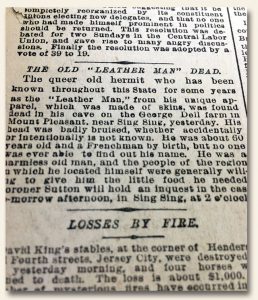 Westchester and Connecticut from the Connecticut River to the Hudson living in caves in the years 1858–1889.” Like clockwork, apparently, he completed his circuit every year and was greeted and given hospitality by many along the way who would normally reject any other vagrant. The internet provides an intriguing image of this leather patchworked fellow in his exile from the rhythms of normal life.
Westchester and Connecticut from the Connecticut River to the Hudson living in caves in the years 1858–1889.” Like clockwork, apparently, he completed his circuit every year and was greeted and given hospitality by many along the way who would normally reject any other vagrant. The internet provides an intriguing image of this leather patchworked fellow in his exile from the rhythms of normal life.
And, with the tortured song of the male lead sounding in my head, I wondered at the days preceding his arrival; what made him the man who came to be known this way?
Was he tormented and driven to trudge through the days, or was this a happy occupation for a human being – leaving behind the established cares of civilized life, content to cover so much ground in so many hours for the prescribed revolutions of the sun? Either way, or something in-between, he made it to the second page of The New York Times. For all the documentation housed here, how many millions of unread or even untold stories must there be?
Anyway, I am back at work, tracking down first, second and third day accounts of the original murder that inspired Capote’s “In Cold Blood” and pulling the obituary for a man who had no known name or history of origin. Next week I am determined to look at these territory papers that are so desirable, and maybe delve into the popular Gentleman’s Magazines with their coveted battle maps.
All of which remind me of one theory concerning the Leather Man: that he was an ex-French soldier. Perhaps that’s true, and all the years of marching over fields and sleeping rough became a way of life he ultimately could not break. Whatever compelled him, day after day, I’m fairly certain a tragic musical score is appropriate.
The July (2017) Newsletter from Rare & Early Newspapers…
July 18, 2017 by GuyHeilenman · Leave a Comment
 Each month the staff of Timothy Hughes Rare & Early Newspapers sends out a newsletter to our members which includes special offers, discounts, alerts to new inventory, and information related to the rare newspaper collectible.
Each month the staff of Timothy Hughes Rare & Early Newspapers sends out a newsletter to our members which includes special offers, discounts, alerts to new inventory, and information related to the rare newspaper collectible.
The July, 2017 newsletter is as follows:
Dear Friend of Rare & Early Newspapers,
|
|
If you would like to receive these free monthly newsletters, along with additional news and alerts concerning the hobby, go to:
FREE RARE & EARLY NEWSPAPERS MEMBERSHIP
Collecting the Revolutionary War on a budget…
March 28, 2013 by TimHughes · 2 Comments
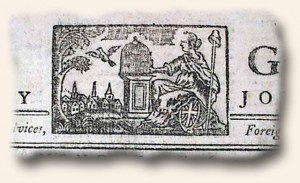 I would argue that beyond the Civil War, the era of American history which evokes the most interest among our collectors is unquestionably the Revolutionary War. With a cast of characters who still rank among the most memorable in history—Washington, Adams, Hancock, Jefferson, Henry, Franklin, Paine, and more—and a plot, which if it were not true history would serve as an excellent screenplay for an exciting movie—an oppressed, energized people seek to break free from the reigns of oppression and dominance from abroad—it is easy to see how the events of the Revolutionary War continue to intrigue and offer a foundation upon which to reflect as today’s world grapples with many of the same issues despite the 230+ years which distance us from those notable events.
I would argue that beyond the Civil War, the era of American history which evokes the most interest among our collectors is unquestionably the Revolutionary War. With a cast of characters who still rank among the most memorable in history—Washington, Adams, Hancock, Jefferson, Henry, Franklin, Paine, and more—and a plot, which if it were not true history would serve as an excellent screenplay for an exciting movie—an oppressed, energized people seek to break free from the reigns of oppression and dominance from abroad—it is easy to see how the events of the Revolutionary War continue to intrigue and offer a foundation upon which to reflect as today’s world grapples with many of the same issues despite the 230+ years which distance us from those notable events.
And what could be better than experiencing those events just as those who lived through them? Newspapers offer that opportunity. Genuine issues, once held and read by those who lived through those turbulent days before being relegated to the back shelves of libraries, are now part of the inventory of Hughes Rare & Early Newspapers. And at prices which might surprise many (see Revolutionary War issues for $60 and under), as a hobby which is relatively unknown to the collecting world has yet to cause demand and scarcity to drive prices beyond the means of the average collector. Of course, there are still many that fall into the category of what we refer to as, “The Best of the Best – Revolutionary War Edition“.
Of significance is that British titles, which offer excellent coverage of all American events given their role in attempting to placate the demands of the Americans while maintaining control of their colonies, allow ownership of battle reports of the war for under $100, with 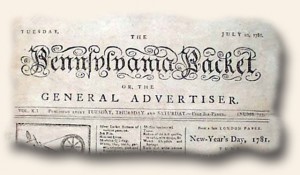 some very notable events in the $200-$300 range. American newspapers remain among the most desired but their scarcity is reflected in their prices. With a collection of the “Pennsylvania Evening Post” which included the Declaration of Independence bringing $600,000 in auction recently, it would amaze many that the same document is available in London’s “Gentleman’s Magazine” issue of August, 1776 (took news 3-4 weeks to traverse the Atlantic) for under $4,000. Other disproportionate prices between British and American newspapers entice many to gravitate to the British titles while prices and availability remain attractive.
some very notable events in the $200-$300 range. American newspapers remain among the most desired but their scarcity is reflected in their prices. With a collection of the “Pennsylvania Evening Post” which included the Declaration of Independence bringing $600,000 in auction recently, it would amaze many that the same document is available in London’s “Gentleman’s Magazine” issue of August, 1776 (took news 3-4 weeks to traverse the Atlantic) for under $4,000. Other disproportionate prices between British and American newspapers entice many to gravitate to the British titles while prices and availability remain attractive.
The “London Chronicle” is one of the better British titles in reporting the Revolutionary War. From the Battle of Lexington and Concord, to Bunker Hill, Battle of New York, Saratoga, Washington crossing the Delaware, treason of Benedict Arnold, Guilford Court House, to Cornwallis’ surrender at Yorktown, this newspaper offers coverage which equals the American newspaper accounts. In fact many British reports were taken verbatim from American newspapers. Of equal quality in report news of the day was the “Edinburgh Evening Courant” from Scotland as I have found all events of the Revolutionary War to be reported in this title as well. Other UK titles which covered the war include “The Glocester Journal”, “Aris’s Birmingham Gazette”, the “Edinburgh Advertiser” and the “Glasgow Mercury” to name a few.
But perhaps the best and most available title of the Revolutionary War period would be the “Gentleman’s Magazine” from London, it having a long printing history from 1731 to the 20th century so it encompasses not just the Revolutionary War in great detail by the entire scope of American history. As an added treat this title typically included one of more plates within each issue, which included maps as well. And during the years of the Revolutionary War were found many maps of American colonies, battle sites as well as large foldout maps showing the entire scope of the united colonies at that time. The maps alone have found a keen interest among collectors, separate from the issues in which they were stored for over 200 years. As is true with the British titles mentioned, “Gentleman’s” included all notable events and documents, including the Articles of Confederation, the Causes and Necessity For Taking Up Arms, all major battles of the war thru the treaty between Washington and Cornwallis, and even the document by King George III which officially ended the war. And all the major names of the war from both the British and American sides have found their way into the pages of “Gentleman’s Magazine”.
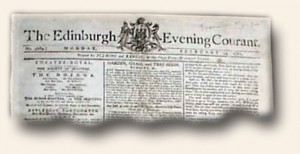 American titles are available as well. Some of the more rare would be those from the South which are virtually impossible to find, and when they do surface their prices are beyond the means of most collectors. Some of the more commonly found titles would be the “Pennsylvania Evening Post” from Philadelphia, the “Pennsylvania Ledger” “Boston Gazette” (which featured an engraving by Paul Revere in the masthead), “The Pennsylvania Gazette” and “Pennsylvania Packet” among others. And dipping back a few years before the outbreak of the war, when tensions were building with much evidence in the newspapers of the day, the “Pennsylvania Chronicle” and the “Boston Chronicle” offer excellent insight into events of the day from the years 1767-1769 for under $200 for most issues.
American titles are available as well. Some of the more rare would be those from the South which are virtually impossible to find, and when they do surface their prices are beyond the means of most collectors. Some of the more commonly found titles would be the “Pennsylvania Evening Post” from Philadelphia, the “Pennsylvania Ledger” “Boston Gazette” (which featured an engraving by Paul Revere in the masthead), “The Pennsylvania Gazette” and “Pennsylvania Packet” among others. And dipping back a few years before the outbreak of the war, when tensions were building with much evidence in the newspapers of the day, the “Pennsylvania Chronicle” and the “Boston Chronicle” offer excellent insight into events of the day from the years 1767-1769 for under $200 for most issues.
Regardless of your interest in the Revolutionary War, whether it be the famous names that came to prominence, the battles of the war, or a focus on a singular event or locality, genuine newspapers of the day are available for the collector. It is a hobby with limitless possibilities, and offers a unique opportunity to literally hold history in your hands.
The 1600’s and 1700’s on a budget…
March 25, 2013 by TimHughes · Leave a Comment
A genuine collectible, over 300 years old, for $60 or less. Is there a field of collecting today which has items of such age– in nice condition–for $60? The hobby of collecting rare & historic newspapers likely sits at the top of what must 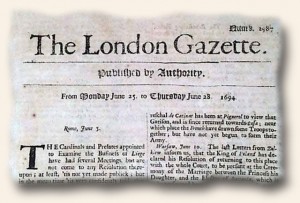 be a very short list. And such prices, along with tremendous availability of titles & content, are part of the intrigue of this fascinating hobby which remains unknown to almost everyone. And this, in large part, is the reason prices are outrageously low in comparison to the relative rarity of other collectibles. While issues do run the gamut price-wise from newsbooks (at the upper end) to coffeehouse newspapers (typically at the lower end), it is a fascinating field for the historical hobbyist on a budget ($20 and under).
be a very short list. And such prices, along with tremendous availability of titles & content, are part of the intrigue of this fascinating hobby which remains unknown to almost everyone. And this, in large part, is the reason prices are outrageously low in comparison to the relative rarity of other collectibles. While issues do run the gamut price-wise from newsbooks (at the upper end) to coffeehouse newspapers (typically at the lower end), it is a fascinating field for the historical hobbyist on a budget ($20 and under).
The ‘London Gazette‘ is the world’s oldest continually published newspaper, having begun in 1665 and is still publishing today. With such historical depth you would expect to find virtually every major event in world history within its pages, and you would be right. The Great Plague and Great London Fire, William Penn being granted land in the New World, the death of noted pirate Captain Kidd, the battles of the French & Indian War and Revolutionary War and so much more are found in not only this title but other newspapers of the era. First reports of such notable events can sell in the thousands of dollars, but an interesting facet of this hobby is that follow-up reports of a few days later can fall well within the comfort level of the average collector.
Both age and graphic appeal come together in the London ‘Post-Boy‘ newspaper, with issues from the 1718-1725 period featuring two ornate engravings in the masthead in addition to a very decorative first letter of the text. Add to this the relative small size of this single sheet newspaper and you have a terrific item for display for under $55.
With American newspapers not beginning until the first decade of the 18th century (one title was published in 1690 but lasted just one day), and most American newspapers through the Revolutionary War being very rare, British titles are an excellent source for collecting all the notable events not only in American history, but in world history as well. And the reporting was often extensive, for remember that the colonies were part of Great Britain through 1776.
The ‘London Chronicle’ was a popular British newspaper which documented amongst its pages virtually all American events since its founding during the French & Indian War. Yet another periodical, the ‘Gentleman’s Magazine‘, is an 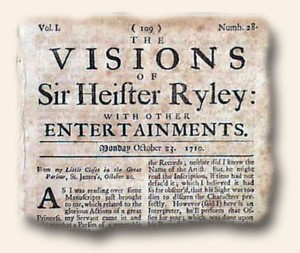 excellent source for period reports of American events since its beginning in 1731, and one of its features was the printing of maps of all corners of the globe, many of which show North America and specific colonies. From James Oglethorpe’s settling the colony of Georgia, to Ben Franklin‘s famous kite experiment, installation of the Liberty Bell, the enactment & repeal of the hated Stamp Act, all events of the Revolutionary War, to the mutiny on the Bounty & so much more, the ‘Gentleman’s Magazine’ offers a terrific repository of American and world history at very affordable prices. Plus, there are reports of Colonel George Washington from 1754 when he was just 22 years old and relatively unknown, and for the music buffs there are works by the composers Hayden, Handel, and death reports of Mozart and Beethoven within its pages. The early battles of Napoleon & other European reports are logically found in this title as well.
excellent source for period reports of American events since its beginning in 1731, and one of its features was the printing of maps of all corners of the globe, many of which show North America and specific colonies. From James Oglethorpe’s settling the colony of Georgia, to Ben Franklin‘s famous kite experiment, installation of the Liberty Bell, the enactment & repeal of the hated Stamp Act, all events of the Revolutionary War, to the mutiny on the Bounty & so much more, the ‘Gentleman’s Magazine’ offers a terrific repository of American and world history at very affordable prices. Plus, there are reports of Colonel George Washington from 1754 when he was just 22 years old and relatively unknown, and for the music buffs there are works by the composers Hayden, Handel, and death reports of Mozart and Beethoven within its pages. The early battles of Napoleon & other European reports are logically found in this title as well.
While American newspapers of the Revolutionary War and before are generally pricey, ranging in the $400 – $1000+ range, two notable exceptions exist being the ‘Boston Chronicle’ and the ‘Pennsylvania Chronicle’, both from the 1768-1769 years. Because their circulation was widespread they are among the more commonly held colonial titles by institutions, & consequently come on the market when libraries convert from hard copy to microfilm or digital. They detail the entire spectrum of American life from just before the Revolutionary War while providing an interesting perspective on American politics during those critical years. Complete, genuine issues are typically available for under $200.
American newspapers from after the American Revolution become more available and at dramatically lower prices while still containing a wealth of notable content on the founding years of the federal government. The ‘Pennsylvania Packet’ of Philadelphia was one of the more successful titles, and was the very first to print the Constitution of the United States. While that issue, September 19, 1787, ranks well into six figures,  dates surrounding it are typically found in the $45 – $80 range and offer a perspective of life in the city where and when the Constitution was being created. The ‘Columbian Centinel’ from Boston was perhaps the most successful title in 18th century America and its pages document the complete scope of America politics and life from 1785 thru Washington’s election and inauguration to his death just weeks before the end of the century.
dates surrounding it are typically found in the $45 – $80 range and offer a perspective of life in the city where and when the Constitution was being created. The ‘Columbian Centinel’ from Boston was perhaps the most successful title in 18th century America and its pages document the complete scope of America politics and life from 1785 thru Washington’s election and inauguration to his death just weeks before the end of the century.
Other 18th century American titles which are within the budgets of even the most modest collectors are the ‘Connecticut Courant’, ‘Dunlap’s American Daily Advertiser’, ‘Gazette of the United States’, the ‘Massachusetts Spy’, and ‘The Herald, A Gazette For The Country’ and others. Nice issues from the formative years of the federal government can be had for under $50 each.
While first reports of the most historic events of the 17th and 18th centuries will always command top dollar among the most savvy of collectors, the hobby of collecting rare newspapers offers a tremendous wealth of issues at surprisingly low prices, while at the same time offering fascinating content on life only known to others through history books. And this hobby is one that offers the entire spectrum of political, economic, and social history to every collector. What other hobby can make that claim? But perhaps most importantly, this hobby let’s you hold—quite literally—history in your hands.
America history in British newspapers…
May 23, 2011 by TimHughes · Leave a Comment
 After 35 years in the hobby I can honestly say today as I said then: collecting early newspapers is an inexpensive hobby when compared to other collectibles of like vintage. And the reason is basic economics: supply and demand. Although the collecting fraternity has increased through the years, and the supply of early newspapers has dwindled some, prices still remain a relative bargain for material over 100—and over 200—years old.
After 35 years in the hobby I can honestly say today as I said then: collecting early newspapers is an inexpensive hobby when compared to other collectibles of like vintage. And the reason is basic economics: supply and demand. Although the collecting fraternity has increased through the years, and the supply of early newspapers has dwindled some, prices still remain a relative bargain for material over 100—and over 200—years old.
Exceptions exist. American newspapers of the 18th century are few and far between today. When I began in the hobby in the mid-1970’s, finding the occasional 18th century bound volume of American newspapers was rather common. I even purchased a number of volumes of colonial and Revolutionary War newspapers printed in the colonies. Such purchases are very rare today, and consequently prices for American titles before the1790’s can be exorbitant for many collectors.
Which brings me to this topic. We are fortunate in this hobby to have a terrific alternative to American newspapers of the colonial era: British newspapers. Keeping in mind that the American colonies were British possessions at the time, considerable American reporting was not uncommon (and I can attest that American newspapers of the same period had considerable European reports!). In fact most British newspapers took their accounts directly from American newspapers so the reporting was identical. And the added bonus of British newspaper reports is commentary with a British bias, offering an interesting perspective to what we remember from history class.
Hobbyists of 25 – 50 years ago eschewed British titles because American titles were so common. But today the collecting market is much different. In many respects I see today’s availability & pricing of British titles much like the situation with American titles 50 years ago. We can find major American events of the colonial era at prices still under $1000 (higher for the “best of the best”) in the London Chronicle or like titles, and under $300 for second tier events. We find there is typically a 5 fold price difference between reports in American versus British newspapers. We’ve sold the Boston Tea Party for $1150 in the London Chronicle. In an American newspaper a like account would exceed $6000. We’ve sold the Boston Massacre in the London Chronicle for the same price. And it would easily exceed $6000 in an American title. One of the most significant documents of the Revolutionary War, “The Causes & Necessity For Taking Up Arms”, we sell as a $340 item in the Gentleman’s Magazine, yet we sold it for $5550 in the New England Chronicle. Same complete document, both from 1775, one within the budget of most collectors, the other not.
But prices are rising for British imprints as more collectors are becoming aware that if they want their collection to contain all the significant events of the 18th century, British newspapers and magazines are their only alternative. The Declaration of Independence remains the most desired event for American collectors. An American newspaper printing is beyond the budgets of almost all collectors, if available at all. An auction price of $50,000 – $75,000 would be expected, while we recently sold the same document in the London Chronicle for $8775. But I will also note it was not long ago that we sold it for $4450. Our current price for a front page account of the Battle of Lexington & Concord in the London Chronicle is $985. Our previous sale of the identical dated issue was $440.
Where will the hobby be with such events in another 25 years? Will all 18th century newspapers–American and British–be considered museum pieces? Much will determine where prices go and I will not hazard a guess. But I am pleased that as the hobby enters a crossroad in availability versus pricing, we currently have a reasonable path to follow for the foreseeable future. These are interesting times for the collecting fraternity.
Editorial policy (?) and the potential impact upon an issue’s collectibility…
April 11, 2009 by GuyHeilenman · Leave a Comment
The following are a few thoughts by Morris Brill (guest contributor) concerning slight differences in the printing of the Declaration of Independence within the London Chronicle (dated August 17, 1776) vs. the printing within the Gentleman’s Magazine (dated August, 1776):
Recently on Ebay two different sellers offered a printing of the Declaration of Independence in the Gentleman’s Magazine. I also noted your offering of the Declaration within the London Chronicle.
I (Morris) noted, while reading the text of Gentleman’s Magazine, as photographed on Ebay, a particular sentence in which two words were missing and substituted with a line, i.e. ___________
 The sentence is as follows:
The sentence is as follows:
“A prince, whose character is thus marked by every act which may define a tyrant, is unfit to be the ruler of a free people.”
In the Gentleman’s Magazine the words ” prince” and “tyrant” are deleted.
I find it interesting that although the Gentleman’s Magazine and the the London Chronicle are both British that one paper printed the words prince and tyrant, yet the other did not.
To me, the deletion of the two words certainly diminishes the historic value of the printing as it appeared in the Gentleman’s Magazine, although I would not pass up the opportunity to own this paper. Perhaps it has to do with an opposing editorial policy, or the political persuasion of the two publishers.
Morris
Note: If anyone is aware of the formal policy which led to the deletion of certain words within the Gentleman’s Magazine, please share your insight with the rare newspaper community.
The Green Mountain Boys…
October 30, 2008 by Historys Newsstand · 1 Comment
A few years ago while looking for Revolutionary War content for the catalog, I was both surprised and delighted to discover a report in the February, 1781 issue of Gentleman’s Magazine that mentioned the famous Green Mountain Boys of Vermont, and their equally famous leader Ethan Allen. The report reads: “Letters of a late date from America, formerly a rebel colonel, who resided at Bennington, in the upper part of New York, not well used, as he thought, by the Congress, has marched off with six hundred Green-mountain Boys, as they style themselves, and joined Major Carlton at Ticonderoga; and it is thought other townships will follow their example.” Although I have seen various newspaper reports mentioning Ethan Allen, this was the first and maybe the only reference to the Green Mountain Boys that I have seen in my twelve years at Hughes Rare & Early Newspapers.
famous Green Mountain Boys of Vermont, and their equally famous leader Ethan Allen. The report reads: “Letters of a late date from America, formerly a rebel colonel, who resided at Bennington, in the upper part of New York, not well used, as he thought, by the Congress, has marched off with six hundred Green-mountain Boys, as they style themselves, and joined Major Carlton at Ticonderoga; and it is thought other townships will follow their example.” Although I have seen various newspaper reports mentioning Ethan Allen, this was the first and maybe the only reference to the Green Mountain Boys that I have seen in my twelve years at Hughes Rare & Early Newspapers.
If you’ve come across another report mentioning the Green Mountain Boys by name, feel free to share it.
Editor’s Note: Marc Pompeo is one of our in-house historians who has been on staff for more than a decade.


